Smart City Inside - Huawei View
In the smart city concept, the familiar infrastructure of utilities and livelihoods is equipped with modern sensors, controllers and video cameras, connects to broadband networks and integrates with the platform for data collection and processing. All these data are analyzed and allow us to achieve a new level of efficiency and optimization of the work of city services and local business, whether it be spending resources or managing passenger traffic.
In theory, everything looks simple, but in fact, those who develop the ideology of a smart city have to deal with a lot of barriers, both typical for large-scale IT projects and individual, for example, for utilities. And this seriously complicates the process.

Some time ago we presented our vision of a smart city - the concept of Smart / Safe City. Under the cut - a detailed look at it from the perspective of business and technical experts.
The concept of a smart city (Smart / Safe City) includes components from various areas of life, the consumers of which are both business and government organizations, as well as urban residents themselves. And before we talk about the details of the idea, let's take a look at its main components.
In large cities, we are used to using intelligent traffic analysis and route planning services. The basis of such services is the collection and processing of data on the movement of vehicles within the road network. But the concept of smart transport is much broader. Equipping vehicles with location and speed sensors, as well as video surveillance cameras allows you to solve a variety of tasks, from security to logistics management: sensors allow you to understand where the car is, what it does and how it can plan its future route.
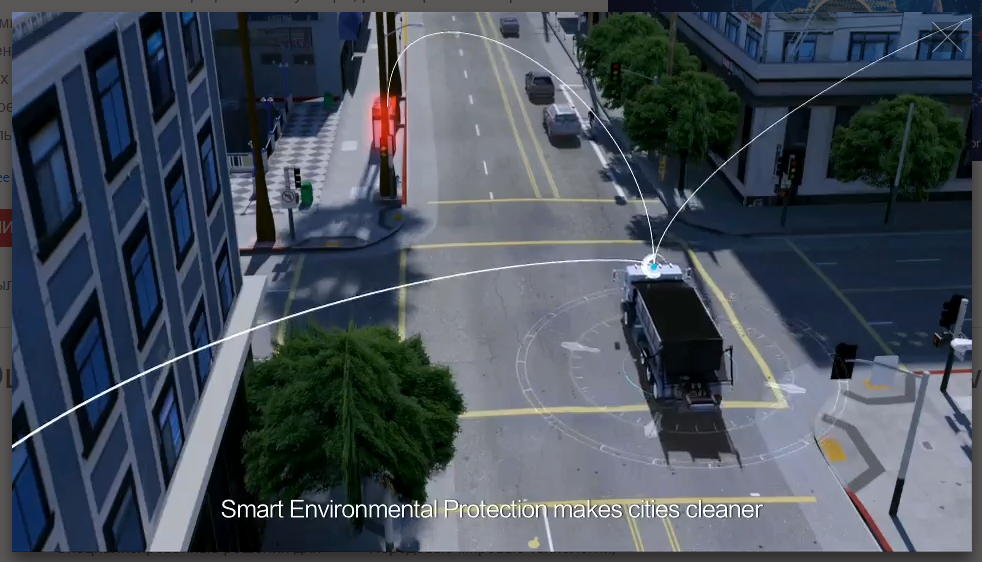
What can give business and urban smart transport:
A good example of the implementation of the concept is one of our solutions for the Chinese market. In partnership with several manufacturers, cars on the conveyor are equipped with the necessary equipment to integrate with the transport management system after the release. By the way, this system was also launched in Chisinau.
The development of intelligent transport ideas will lead to the emergence of a full-fledged autopilot for private cars and, accordingly, to the departure of the driver's profession into the past. However, on the way to this a lot of technological and legal issues have to be resolved, so it’s not clear whether this will happen in the next decade (and, especially, in Russia).
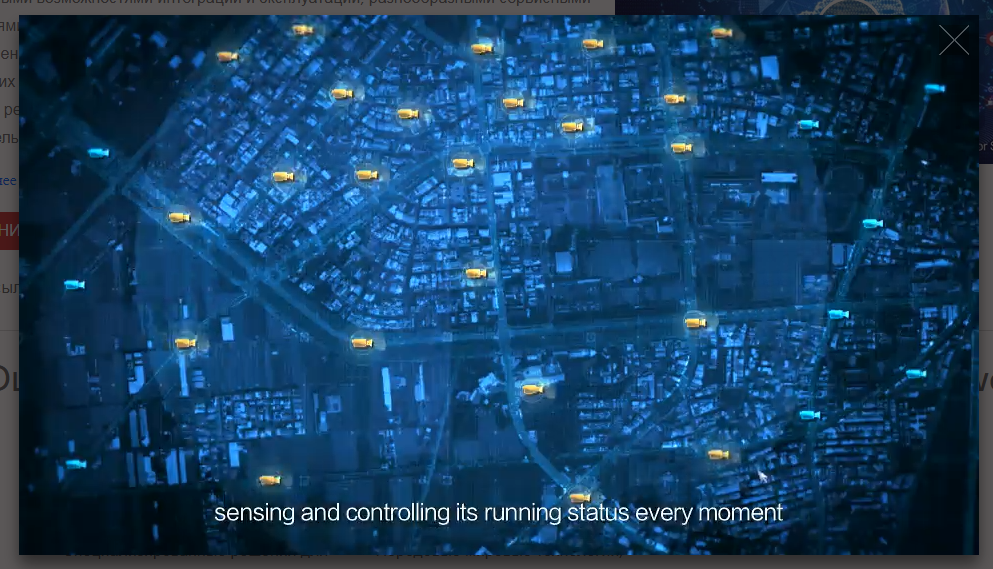
One of the most popular and well-developed scenarios of a smart city today is security (in the context of protection against crime).
City streets around the world are equipped with video surveillance cameras connected to a unified system for collecting and processing information, which reduces the number of crimes. This concept is well illustrated by the example of Kenya, where, as modern networks are deployed and the Safe City project is being implemented, the average crime rate throughout the country in 2015 alone fell by 46%.
However, video surveillance is only the tip of the iceberg. Smart police is an attempt to transform the usual service into a more effective tool for ensuring law and order in the face of increasing population density. There is a huge layer of technologies that the ordinary user simply does not notice. In addition to the video surveillance system itself, this may include:
Of course, the transition to smart police is also a social transformation that allows the community to participate in maintaining order.

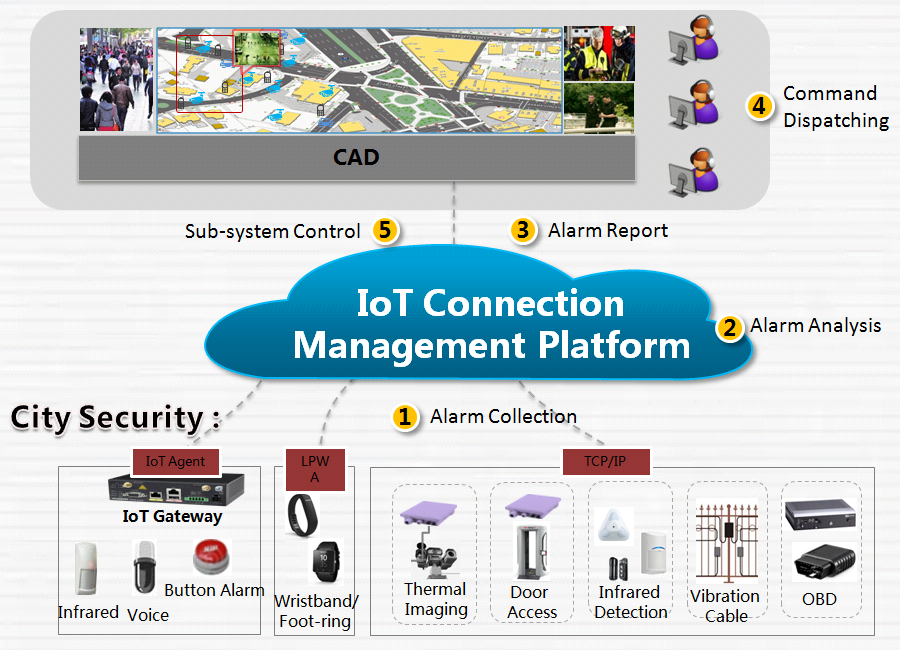
In the future, the concept of smart police implies the creation of situational centers where all the information collected by the infrastructure of a smart city flows, especially from critical points. Seeing the whole situation in the complex, emergency services can make decisions more quickly.

In the long-term perspective, “safe city” projects should negate street crime, because it is absolutely pointless to steal handbags if, by analyzing the recordings of surveillance cameras in the incident zone and tracking the criminal’s route through the cameras of neighboring streets, 10 minutes after the theft, the attacker is arrested.

Obviously, accurate accounting of consumed resources allows you to manage the load or make savings.
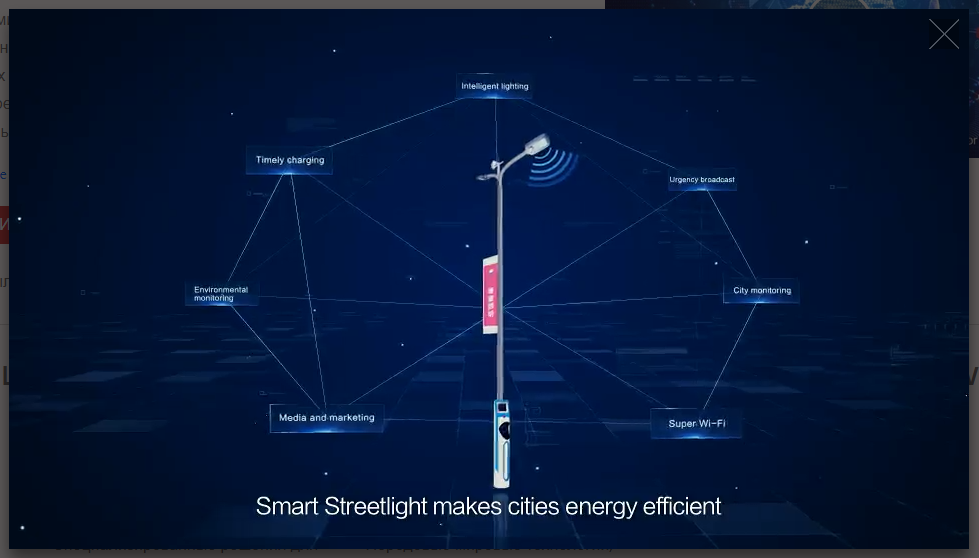
Although consumption counters of various resources are being introduced for a long time, in this area, if I may say so, even “Level 0” is not passed yet - that is, the introduction of intelligent systems is at the initial stage. It is necessary not only to introduce sensors in all areas of housing and public utilities, but also to collect data into a single platform for centralized management. On a national scale, this is a task for years and billions of dollars in budgets.
There are examples of cities in the world that are actively implementing smart consumption of resources. In particular, Barcelona has implemented automated street lighting control based on the time of day and weather conditions. Given the favorable climatic conditions (and serious problems with pollution of urban air), solar energy is actively used here - for heating water in buildings, as well as for powering interactive public transport boards. With the participation of the city, a modular open source platform, Sentilo, is being developed, which collects and analyzes information from consumption meters of basic resources, weather sensors, ambient noise, etc. (the system has been operating for more than three years, its work can be assessed on the official website sentilo.io ). In 2015, Barcelona was awardedthe title of "the smartest city on the planet."


Another example is the Chinese city of Shenzhen (IT-capital of China), where city water supply systems were equipped with sensors of our smart city system. In total, the system contains about two million sensors that collect information from different points and allow real-time control of the water supply situation.
Smart education and health care (as well as another area - mass events and tourism) can save not so much as increase the quality of life in the city.
Broadband networks provide an opportunity to significantly expand the audience listening to a particular training course. For this, educational institutions are equipped with electronic boards and cameras, as well as telepresence systems. At different levels of education, this allows solving various tasks - from providing compulsory secondary education to people with limited mobility to distant higher education at leading universities in the country.
Similar systems in medicine, for example, in the form of a mobile cart with diagnostic devices, a computer, video camera, etc., allow serving patients in hospitals on the outskirts or in regions, using the advice of more qualified specialists from the center.
It should be noted that the division of industries in this list is very conditional. Many problems are solved at the junction, for example, resource analysis and logistics. A good example of such a project is intellectual garbage collection in Dubai Silicon Oasis (a free economic zone in Dubai, where smart city technologies are being actively implemented).
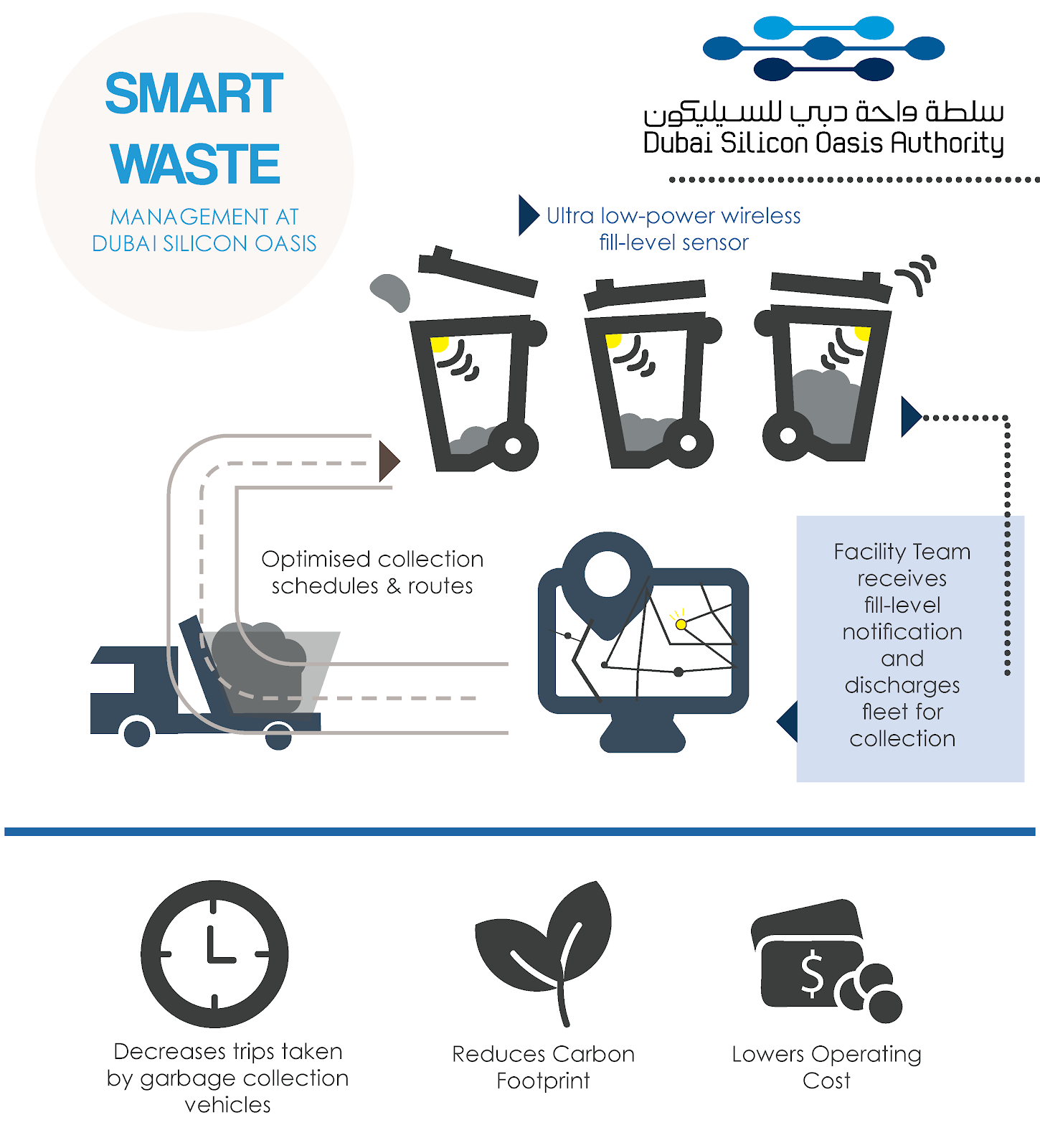
The routes of cars taking out the garbage are not planned according to the schedule, but taking into account the readings of the sensors of the garbage containers, which arrive at the coordination center in real-time mode.
In addition, there are ideas that bring together solutions from several areas at once. For example, smart office buildings that are part of a smart city. Smart building introduces accounting and intellectual management of the consumption of basic resources at its level, which ultimately affects the efficiency of the “work” of the systems of the entire city.
From the business point of view, there are several serious barriers for the development of real projects within the framework of the smart city concept, which need to be addressed.
The individual components of a smart city have been developing in different cities for a long time. However, there are not so many worked-out business models that have managed to prove their effectiveness specifically for business.
The main stumbling block is the payback period for projects. Business needs market strategies that will bring profit in the next five years (in Russia, taking into account the economic situation - within three years), and a smart city is an investment in more distant prospects. And the mismatch of business cases is a serious brake on the development of a smart city; This is one of the main factors for which smart city is not developing as actively as they could.
So far, the overwhelming majority of projects in the world include budget money as a compulsory component (and therefore, a certain national task), that is, it is a question of strategic infrastructure development.
For example, in the Czech Republic built a smart lighting along the roads. The project was initiated by the business and paid off. But one of its main components was the replacement of lighting lamps. And such tasks, as a rule, are carried out by municipalities at their own expense.
It would seem that a business model can be built on the experience of colleagues from other cities, the benefit of examples, like the Czech Republic mentioned above, is numerous. But the difficulty is that they are poorly replicated. An analogue of the Czech project in Russia is not likely to pay off, since we have completely different conditions for electricity supply, electricity prices and the size of the road network.
By the way, in Russia the cost of core resources relative to other countries of the world is relatively low, which translates into a slightly different economy of savings projects. This is partly why the concept of a smart city begins on the other hand, with security. Yes, St. Petersburg and Moscow, to a certain extent, are already equipped with video surveillance cameras. But in other million-plus cities and, especially in the regions, the situation with them is much worse.
Therefore, the first task is to increase the level of security in the cities, obviously, through the introduction of video recording systems and video analytics, which automatically cut off a large proportion of street crimes. In our realities, this is the most understandable case: it is clear how to use it and why it is needed; it is easier to justify the costs.
In general, local specificity is extremely important for a smart city project, because in every city in the world people think differently, they have different needs and problems.
Special mention requires the issue of security of the smart city system itself. After all, every smart sensor or device can become an entry point for intruders. Sensor software can be modified so that in the presence of "holes" in the security system, it will perform completely different tasks. An example is hacking surveillance cameras, which are then used to carry out powerful DDoS attacks. However, so far the number of such cases has not gained enough “critical mass” for the public to seriously worry about this topic.
It is important that in the context of a smart city, the security of systems acquires a completely different meaning. It is not enough to control the final set of points - there are too many of them. Yes, manufacturers are already embedding functions related to encryption, protection from unauthorized access, etc. into devices. But here we need a fundamentally different approach. And at the current moment there is no comprehensive concept that would unite these separate components. All that is now being implemented is attempts to introduce existing methods of ensuring information security to solve a fundamentally new task. And this is not the best approach.
As a rule, smart city projects are developing as part of the modernization of urban systems, and its depth depends on the existing infrastructure and current needs. Sometimes such projects include building new segments from scratch, but the need to support the remaining obsolete infrastructure almost always complicates the situation.
As in any large IT project, when building a smart city, you have to deal with the infrastructure that has not yet managed to work out its resource (i.e., there is no direct reason to replace it). And this is not only technological obsolete urban systems that do not involve the installation of sensors and automation. The “smart” infrastructure introduced earlier, which is no longer integrated into complex systems, adds its mite or its integration turns out to be too costly.
Building a smart city is a large-scale IT project. Like any IT project, it needs a general concept that includes a description of the infrastructure at various levels, from end devices (sensors) to the center of the system - a platform for collecting and analyzing data, as well as user applications that enable interaction with the smart city.
If we present the entire project of a smart city in the form of a pyramid, where the base level is the end devices (sensors), and the top one is user applications, then we, as an infrastructure company, ensure the functioning of the entire middle of this pyramid. In other words, our smart city solutions include various types of networks, an aggregation and data processing platform, various types of storage systems.
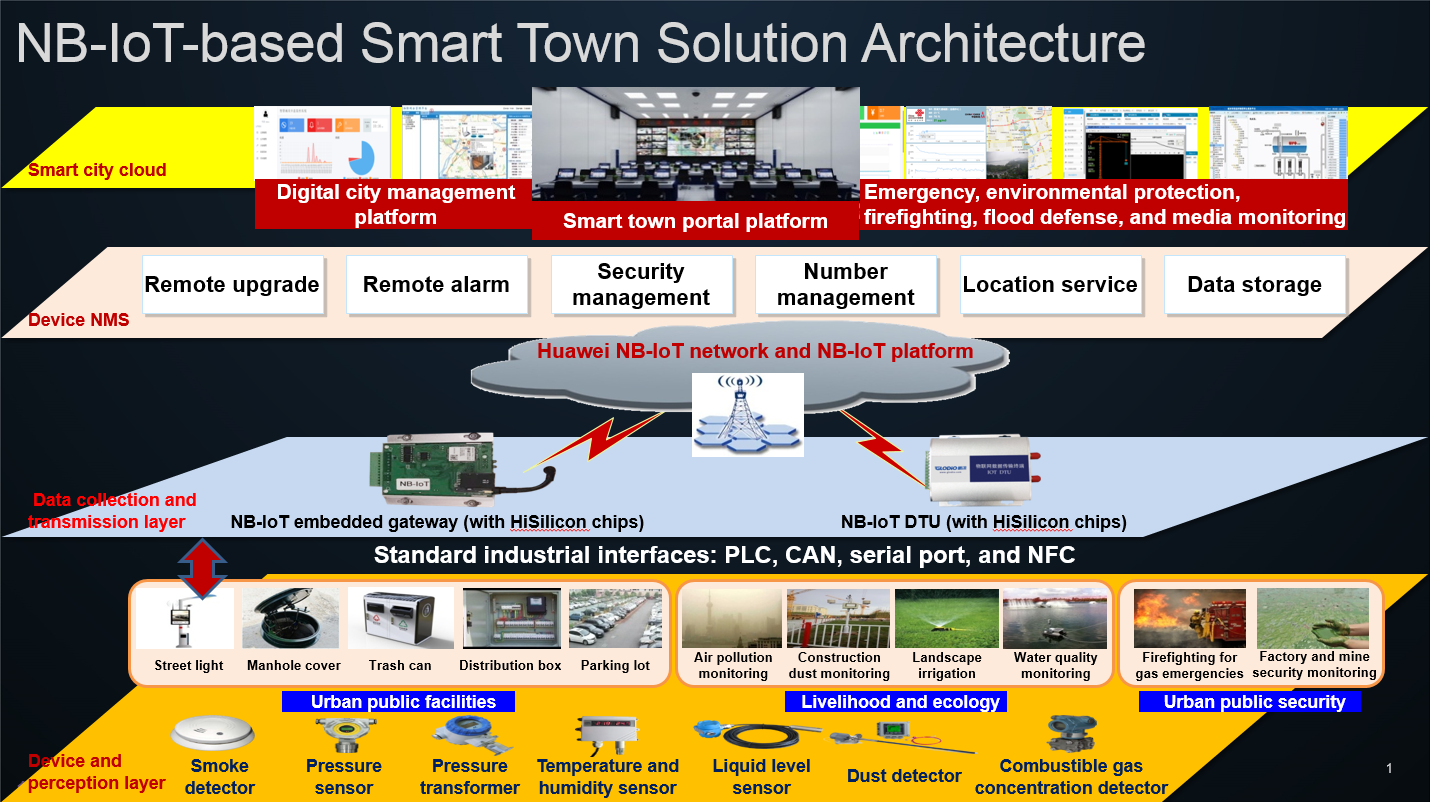
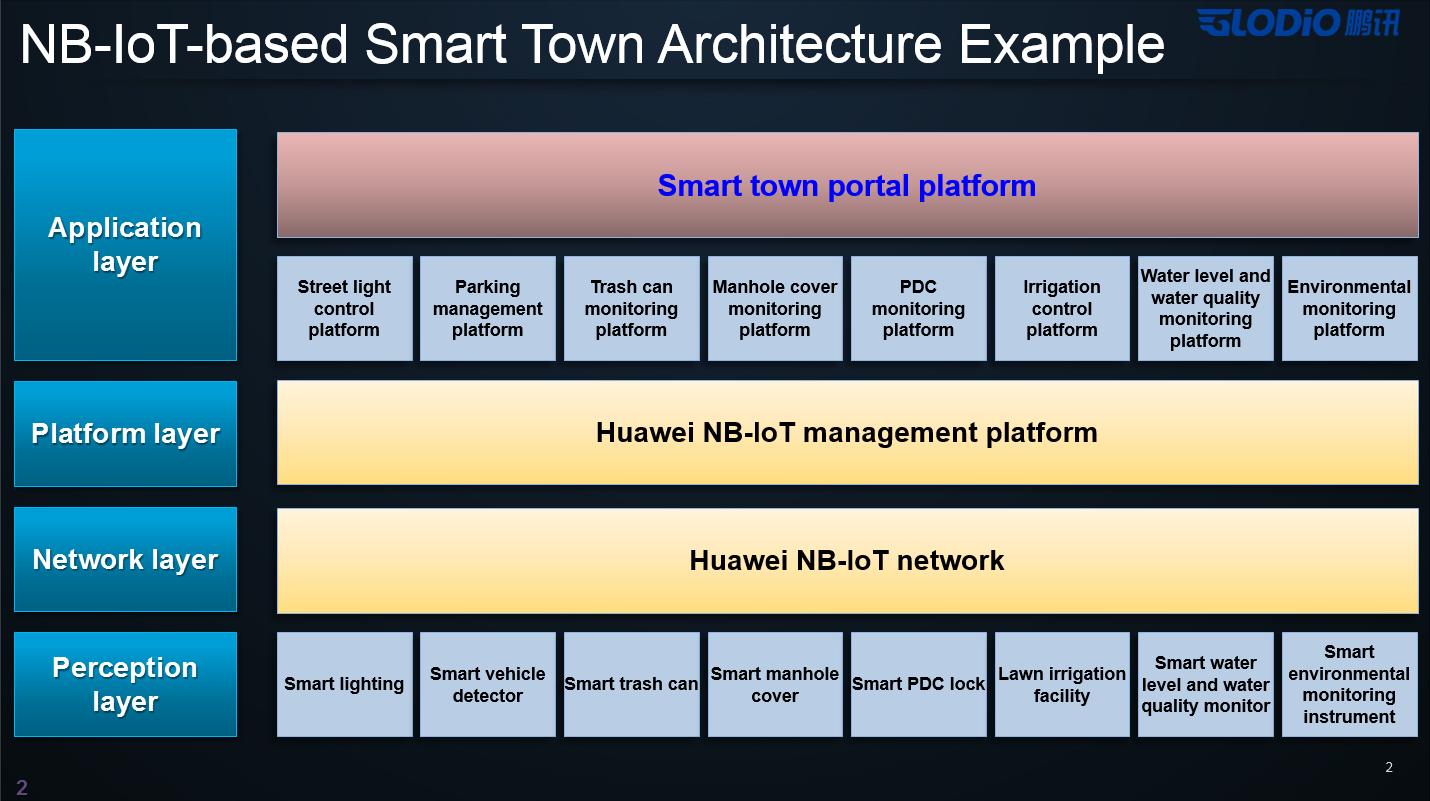
Each level has a certain degree of flexibility, which allows reducing one of the mentioned barriers - for example, problems with inheriting systems that have not yet exhausted their resources.
In theory, a solution similar to the smart city of Huawei can be built on the basis of open or third-party components. But there will have to pay additional attention to the issue of labor costs (cost), as well as the subsequent support of the decision. After all, the developed infrastructure must not only be deployed, but also turned into a working tool. According to the experience of other industries where major IT-solutions are being implemented, opensource projects are living exactly until such time as serious industrial competitors come.
The heart of the system is the OceanConnect mediation platform for data aggregation and processing, providing work with millions of end devices.
Its tasks include the collection of readings from a large number of end devices, their analysis and storage in distributed storage based on Hadoop.
The platform can be deployed as part of a cloud service or on a local infrastructure on a different type of hardware. Naturally, we have our own server hardware for such systems, but in principle it can be deployed on any suitable hardware.
Huawei's infrastructure supports a whole range of generally accepted communication standards and sensor interaction protocols. In particular, connectors are provided for most modern IT protocols. In total, more than 170 interfaces have already been integrated, and the open SDK allows adding new ones if necessary.
The hardware component of the solution is chosen for a specific project, Huawei itself has a whole class of its own DCP solutions (development of Huawei AR with integrated standards and IoT protocols), but third-party products can also be used.
For all sorts of sensors, terminals and controllers, we offer our own chipset and communication module, as well as Linux OS, created on the basis of Linux and oriented to IoT. We leave the final assembly, production of the case and preparation of the power supply scheme, as well as the development of software based on the official SDK to local partners.
On the application side, OceanConnect has an open API for interfacing with external systems.
We initially do not enter the application market, adhering to the opinion that it is pointless for a global manufacturer to compete with local players in understanding the very local specificity that is so important in popularizing the idea of a smart city. Local business will cope better and quickly adapts its systems to these requirements. Therefore, in this part, Huawei seeks to cooperate with local partners. This removes another barrier - accounting by local partners.
Smart cities predict a great future. However, when it comes, it is not clear. Technologically, everything is ready for this: there are Big Data analysis tools, appropriate server hardware, sensors capable of operating for ten years without recharging the battery, and the appropriate communication standards. But this market lacks technological stability - the final choice of dominant standards and the formation of business models, when it becomes clear how you can work and earn money.
We saw a similar process a couple of decades ago in the cellular market. There were a lot of standards then, besides GSM, but now they are all either gone or they occupy certain non-essential niches. In the mass market, GSM won an unconditional victory. A similar process awaits the Internet of things sector. Sooner or later everything will come to one or several general standards and the business model by which the market will work will become clear.
As we have already written, in order for a business to become interested in a smart city, it must understand financial prospects. So far, the market has not settled, and many do not want to be the first - because it is the pioneers who usually get not only the main profit, but also a lot of unsolved problems (and it’s not yet the fact that the profit will eventually cover the search for solutions). However, to postpone this project does not allow another factor - the progressive growth of urbanization in the world. Cities are becoming not only the centers of economic and cultural, but also the main sources of GDP.
The growth of urban agglomerations and the related problems of overpopulation force customers around the world to try various high-tech solutions. And in response to this still low demand, vendors are actively promoting their visions of the concept of smart cities, and we are also actively engaged.
In theory, everything looks simple, but in fact, those who develop the ideology of a smart city have to deal with a lot of barriers, both typical for large-scale IT projects and individual, for example, for utilities. And this seriously complicates the process.

Some time ago we presented our vision of a smart city - the concept of Smart / Safe City. Under the cut - a detailed look at it from the perspective of business and technical experts.
Ideas and components
The concept of a smart city (Smart / Safe City) includes components from various areas of life, the consumers of which are both business and government organizations, as well as urban residents themselves. And before we talk about the details of the idea, let's take a look at its main components.
Smart transportation
In large cities, we are used to using intelligent traffic analysis and route planning services. The basis of such services is the collection and processing of data on the movement of vehicles within the road network. But the concept of smart transport is much broader. Equipping vehicles with location and speed sensors, as well as video surveillance cameras allows you to solve a variety of tasks, from security to logistics management: sensors allow you to understand where the car is, what it does and how it can plan its future route.

What can give business and urban smart transport:
- urban traffic management;
- the work of service fleets and taxis.
A good example of the implementation of the concept is one of our solutions for the Chinese market. In partnership with several manufacturers, cars on the conveyor are equipped with the necessary equipment to integrate with the transport management system after the release. By the way, this system was also launched in Chisinau.
The development of intelligent transport ideas will lead to the emergence of a full-fledged autopilot for private cars and, accordingly, to the departure of the driver's profession into the past. However, on the way to this a lot of technological and legal issues have to be resolved, so it’s not clear whether this will happen in the next decade (and, especially, in Russia).
Security and Police

One of the most popular and well-developed scenarios of a smart city today is security (in the context of protection against crime).
City streets around the world are equipped with video surveillance cameras connected to a unified system for collecting and processing information, which reduces the number of crimes. This concept is well illustrated by the example of Kenya, where, as modern networks are deployed and the Safe City project is being implemented, the average crime rate throughout the country in 2015 alone fell by 46%.
However, video surveillance is only the tip of the iceberg. Smart police is an attempt to transform the usual service into a more effective tool for ensuring law and order in the face of increasing population density. There is a huge layer of technologies that the ordinary user simply does not notice. In addition to the video surveillance system itself, this may include:
- New communication tools to quickly receive information about incidents;
- modern emergency alert systems for employees and the public;
- equipment (robots, sappers, drones, etc.), allowing to replace people in solving dangerous problems or improve search and other measures;
- data collection tools that can be used as an evidence base (audio recording, etc.);
- systems for analyzing all sorts of data, allowing to identify atypical behavior of people or malfunction of the infrastructure at an early stage.
Of course, the transition to smart police is also a social transformation that allows the community to participate in maintaining order.


In the future, the concept of smart police implies the creation of situational centers where all the information collected by the infrastructure of a smart city flows, especially from critical points. Seeing the whole situation in the complex, emergency services can make decisions more quickly.

In the long-term perspective, “safe city” projects should negate street crime, because it is absolutely pointless to steal handbags if, by analyzing the recordings of surveillance cameras in the incident zone and tracking the criminal’s route through the cameras of neighboring streets, 10 minutes after the theft, the attacker is arrested.

Smart Resource Consumption
Obviously, accurate accounting of consumed resources allows you to manage the load or make savings.

Although consumption counters of various resources are being introduced for a long time, in this area, if I may say so, even “Level 0” is not passed yet - that is, the introduction of intelligent systems is at the initial stage. It is necessary not only to introduce sensors in all areas of housing and public utilities, but also to collect data into a single platform for centralized management. On a national scale, this is a task for years and billions of dollars in budgets.
There are examples of cities in the world that are actively implementing smart consumption of resources. In particular, Barcelona has implemented automated street lighting control based on the time of day and weather conditions. Given the favorable climatic conditions (and serious problems with pollution of urban air), solar energy is actively used here - for heating water in buildings, as well as for powering interactive public transport boards. With the participation of the city, a modular open source platform, Sentilo, is being developed, which collects and analyzes information from consumption meters of basic resources, weather sensors, ambient noise, etc. (the system has been operating for more than three years, its work can be assessed on the official website sentilo.io ). In 2015, Barcelona was awardedthe title of "the smartest city on the planet."


Another example is the Chinese city of Shenzhen (IT-capital of China), where city water supply systems were equipped with sensors of our smart city system. In total, the system contains about two million sensors that collect information from different points and allow real-time control of the water supply situation.
Other areas
Smart education and health care (as well as another area - mass events and tourism) can save not so much as increase the quality of life in the city.
Broadband networks provide an opportunity to significantly expand the audience listening to a particular training course. For this, educational institutions are equipped with electronic boards and cameras, as well as telepresence systems. At different levels of education, this allows solving various tasks - from providing compulsory secondary education to people with limited mobility to distant higher education at leading universities in the country.
Similar systems in medicine, for example, in the form of a mobile cart with diagnostic devices, a computer, video camera, etc., allow serving patients in hospitals on the outskirts or in regions, using the advice of more qualified specialists from the center.
It should be noted that the division of industries in this list is very conditional. Many problems are solved at the junction, for example, resource analysis and logistics. A good example of such a project is intellectual garbage collection in Dubai Silicon Oasis (a free economic zone in Dubai, where smart city technologies are being actively implemented).

The routes of cars taking out the garbage are not planned according to the schedule, but taking into account the readings of the sensors of the garbage containers, which arrive at the coordination center in real-time mode.
In addition, there are ideas that bring together solutions from several areas at once. For example, smart office buildings that are part of a smart city. Smart building introduces accounting and intellectual management of the consumption of basic resources at its level, which ultimately affects the efficiency of the “work” of the systems of the entire city.
Implementation problems
From the business point of view, there are several serious barriers for the development of real projects within the framework of the smart city concept, which need to be addressed.
Barrier 1: unclear economy
The individual components of a smart city have been developing in different cities for a long time. However, there are not so many worked-out business models that have managed to prove their effectiveness specifically for business.
The main stumbling block is the payback period for projects. Business needs market strategies that will bring profit in the next five years (in Russia, taking into account the economic situation - within three years), and a smart city is an investment in more distant prospects. And the mismatch of business cases is a serious brake on the development of a smart city; This is one of the main factors for which smart city is not developing as actively as they could.
So far, the overwhelming majority of projects in the world include budget money as a compulsory component (and therefore, a certain national task), that is, it is a question of strategic infrastructure development.
For example, in the Czech Republic built a smart lighting along the roads. The project was initiated by the business and paid off. But one of its main components was the replacement of lighting lamps. And such tasks, as a rule, are carried out by municipalities at their own expense.
Barrier 2: replication difficulties
It would seem that a business model can be built on the experience of colleagues from other cities, the benefit of examples, like the Czech Republic mentioned above, is numerous. But the difficulty is that they are poorly replicated. An analogue of the Czech project in Russia is not likely to pay off, since we have completely different conditions for electricity supply, electricity prices and the size of the road network.
By the way, in Russia the cost of core resources relative to other countries of the world is relatively low, which translates into a slightly different economy of savings projects. This is partly why the concept of a smart city begins on the other hand, with security. Yes, St. Petersburg and Moscow, to a certain extent, are already equipped with video surveillance cameras. But in other million-plus cities and, especially in the regions, the situation with them is much worse.
Therefore, the first task is to increase the level of security in the cities, obviously, through the introduction of video recording systems and video analytics, which automatically cut off a large proportion of street crimes. In our realities, this is the most understandable case: it is clear how to use it and why it is needed; it is easier to justify the costs.
In general, local specificity is extremely important for a smart city project, because in every city in the world people think differently, they have different needs and problems.
Barrier 3: information security
Special mention requires the issue of security of the smart city system itself. After all, every smart sensor or device can become an entry point for intruders. Sensor software can be modified so that in the presence of "holes" in the security system, it will perform completely different tasks. An example is hacking surveillance cameras, which are then used to carry out powerful DDoS attacks. However, so far the number of such cases has not gained enough “critical mass” for the public to seriously worry about this topic.
It is important that in the context of a smart city, the security of systems acquires a completely different meaning. It is not enough to control the final set of points - there are too many of them. Yes, manufacturers are already embedding functions related to encryption, protection from unauthorized access, etc. into devices. But here we need a fundamentally different approach. And at the current moment there is no comprehensive concept that would unite these separate components. All that is now being implemented is attempts to introduce existing methods of ensuring information security to solve a fundamentally new task. And this is not the best approach.
Barrier 4: legacy
As a rule, smart city projects are developing as part of the modernization of urban systems, and its depth depends on the existing infrastructure and current needs. Sometimes such projects include building new segments from scratch, but the need to support the remaining obsolete infrastructure almost always complicates the situation.
As in any large IT project, when building a smart city, you have to deal with the infrastructure that has not yet managed to work out its resource (i.e., there is no direct reason to replace it). And this is not only technological obsolete urban systems that do not involve the installation of sensors and automation. The “smart” infrastructure introduced earlier, which is no longer integrated into complex systems, adds its mite or its integration turns out to be too costly.
Huawei concept
Building a smart city is a large-scale IT project. Like any IT project, it needs a general concept that includes a description of the infrastructure at various levels, from end devices (sensors) to the center of the system - a platform for collecting and analyzing data, as well as user applications that enable interaction with the smart city.
If we present the entire project of a smart city in the form of a pyramid, where the base level is the end devices (sensors), and the top one is user applications, then we, as an infrastructure company, ensure the functioning of the entire middle of this pyramid. In other words, our smart city solutions include various types of networks, an aggregation and data processing platform, various types of storage systems.


Each level has a certain degree of flexibility, which allows reducing one of the mentioned barriers - for example, problems with inheriting systems that have not yet exhausted their resources.
In theory, a solution similar to the smart city of Huawei can be built on the basis of open or third-party components. But there will have to pay additional attention to the issue of labor costs (cost), as well as the subsequent support of the decision. After all, the developed infrastructure must not only be deployed, but also turned into a working tool. According to the experience of other industries where major IT-solutions are being implemented, opensource projects are living exactly until such time as serious industrial competitors come.
Platform aggregation and data analysis
The heart of the system is the OceanConnect mediation platform for data aggregation and processing, providing work with millions of end devices.
Its tasks include the collection of readings from a large number of end devices, their analysis and storage in distributed storage based on Hadoop.
The platform can be deployed as part of a cloud service or on a local infrastructure on a different type of hardware. Naturally, we have our own server hardware for such systems, but in principle it can be deployed on any suitable hardware.
Network infrastructure
Huawei's infrastructure supports a whole range of generally accepted communication standards and sensor interaction protocols. In particular, connectors are provided for most modern IT protocols. In total, more than 170 interfaces have already been integrated, and the open SDK allows adding new ones if necessary.
The hardware component of the solution is chosen for a specific project, Huawei itself has a whole class of its own DCP solutions (development of Huawei AR with integrated standards and IoT protocols), but third-party products can also be used.
End devices
For all sorts of sensors, terminals and controllers, we offer our own chipset and communication module, as well as Linux OS, created on the basis of Linux and oriented to IoT. We leave the final assembly, production of the case and preparation of the power supply scheme, as well as the development of software based on the official SDK to local partners.
End applications
On the application side, OceanConnect has an open API for interfacing with external systems.
We initially do not enter the application market, adhering to the opinion that it is pointless for a global manufacturer to compete with local players in understanding the very local specificity that is so important in popularizing the idea of a smart city. Local business will cope better and quickly adapts its systems to these requirements. Therefore, in this part, Huawei seeks to cooperate with local partners. This removes another barrier - accounting by local partners.
A look into the future
Smart cities predict a great future. However, when it comes, it is not clear. Technologically, everything is ready for this: there are Big Data analysis tools, appropriate server hardware, sensors capable of operating for ten years without recharging the battery, and the appropriate communication standards. But this market lacks technological stability - the final choice of dominant standards and the formation of business models, when it becomes clear how you can work and earn money.
We saw a similar process a couple of decades ago in the cellular market. There were a lot of standards then, besides GSM, but now they are all either gone or they occupy certain non-essential niches. In the mass market, GSM won an unconditional victory. A similar process awaits the Internet of things sector. Sooner or later everything will come to one or several general standards and the business model by which the market will work will become clear.
As we have already written, in order for a business to become interested in a smart city, it must understand financial prospects. So far, the market has not settled, and many do not want to be the first - because it is the pioneers who usually get not only the main profit, but also a lot of unsolved problems (and it’s not yet the fact that the profit will eventually cover the search for solutions). However, to postpone this project does not allow another factor - the progressive growth of urbanization in the world. Cities are becoming not only the centers of economic and cultural, but also the main sources of GDP.
The growth of urban agglomerations and the related problems of overpopulation force customers around the world to try various high-tech solutions. And in response to this still low demand, vendors are actively promoting their visions of the concept of smart cities, and we are also actively engaged.
